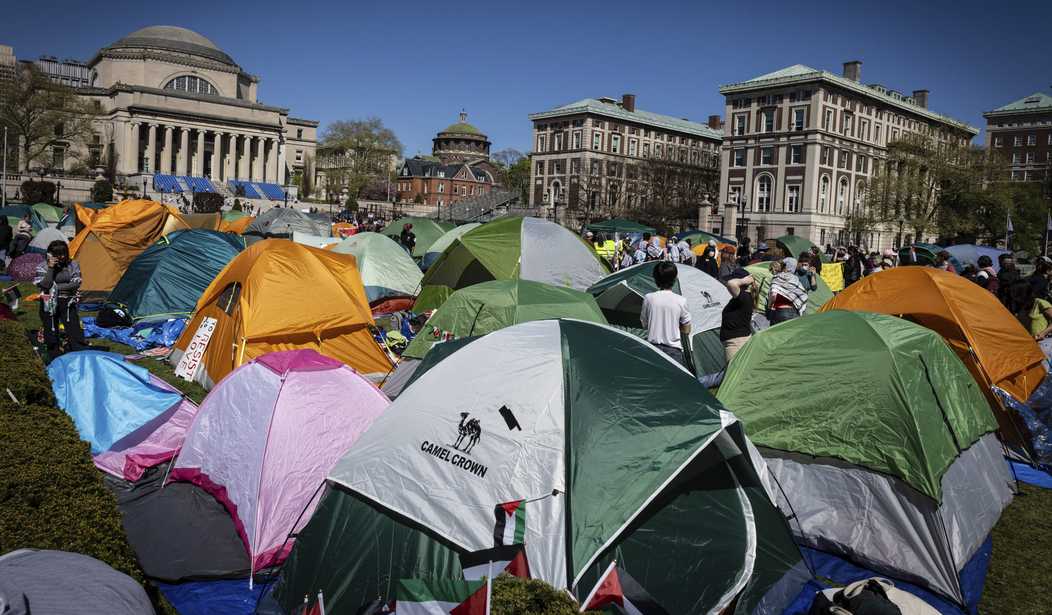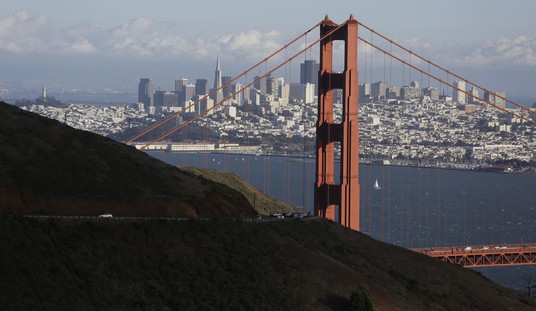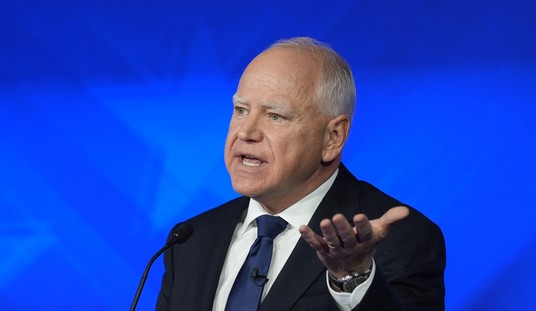A new report written by the Columbia University Senate got a warm welcome from the NY Times. The article is titled "Columbia Campus Occupation Could Have Ended Without Police, Report Says." And that really is the thrust of the article, that Columbia was too harsh toward the people who took over a campus building, trashed it and barricaded the doors.
Columbia University’s move to use police force to clear demonstrators from a campus building last spring could potentially have been avoided, as some students were urgently asking if they could leave voluntarily, according to a report released Tuesday by the university’s senate.
The students, who early that morning had entered Hamilton Hall and barricaded the doors, told faculty intermediaries that they had enlisted the help of a Harlem pastor to help them depart safely. But university administrators, saying time had run out, allowed hundreds of police officers to come onto the campus to remove protesters from the building.
The new details of the final hours of the occupation of Hamilton Hall on April 30 were among the key revelations of the 335-page report, which was written by a group within the senate, a Columbia policymaking body that includes faculty members, students and administrators, with faculty in the majority.
A bit later we get to a slightly more detailed account from the NY Times.
That evening at about 7:20, before police arrived, representatives of the demonstrators contacted members of the senate to ask if students could leave the building without the police entering, the report said. Dr. D’Armiento called Dr. Shafik at 7:49 p.m. to relay that information...
At 8:31 p.m., the report said, Dr. D’Armiento asked Dr. Shafik for 30 more minutes to work with the students. “I know many of the students want the deal and they are trying to get others on board,” she wrote in an email.
Dr. Shafik responded 35 minutes later: “The best is if they left on their own now. Please encourage them to do so for everyone’s sake.” Twenty minutes later, at 9:26 p.m., police officers entered the building and made dozens of arrests.
The Times has left out almost all of the facts that matter here in a transparent attempt to make it seem the "demonstrators" were being reasonable and Dr. Shafik was refusing to give them a few minutes to come out peacefully. This is simply an absurd characterization of what happened that day and all you need to do is look at the timeline in the report to prove it.
First of all, in the days leading up to the takeover CUAD and other groups had been demanding the university divest itself from Israel. They also demanded a statement from the school's president about the harm done to Gaza. But the university refused so by the night of April 27, 2024 the negotiations broke down.
On April 28, CUAD demanded amnesty for all of the students who had been arrested for their involvement in campus encampments. These calls for "amnesty" is something the group has repeatedly called for in the past 18 months. In essence it means no one from their group gets punished no matter what school rules (or laws) they break during their activities. By the evening of the 28th an representative for the encampment notified the school they were done with negotiations.
The next morning, April 29th, President Shafik announced that negotiations with the group had failed. That afternoon, notices were distributed stating that people camping out had until 2pm to clear the lawn. Each student leaving was told they would have to identify themselves to the school and sign a document promising to obey all school rules about the time and manner of protests through the end of the school year or face suspension. The notices concluded, "If you do not leave by 2 p.m., you will be suspended pending further investigation."
At noon, the people in the encampment voted to ignore the notices and stay past the deadline. A picked around the camp started and lasted until about 4:30pm. At that point, the school stated to suspend people still at the camp.
And that brings us to April 30, the day of the Hamilton Hall takeover. The takeover started shortly after midnight. The "demonstrators" had apparently timed it to coincide with a security shift change. This comes from the newly published report:
- At around 12:30 AM, students began a large picket near South Lawn, marching toward the northern end of campus and away from Hamilton. A group of protesters carrying sleeping bags and backpacks diverged from the picket line, picking up black metal barricades and entered Hamilton Hall. The protestors moved metal gates to barricade the doors, blocked the entrances of the building with wooden tables and chairs from classrooms, and zip-tied the doors shut. A protester broke the window of the rightmost door as dozens more formed a human barricade directly outside the doors. As the protestors entered the building, people cheered and clapped.
Members of the cleaning crew were trapped inside and told they couldn't leave.
- In less than five minutes, protesters sealed the building while hundreds more flooded in front of the building. Protestors did not let anyone enter Hamilton after locking down the building.
- Upon entry, protesters quickly set down their belongings and raced up the stairs, bringing tables and chairs from classrooms to block the doors from the inside, covered security cameras with black trash bags and tape, and shuttered the blinds.
- Three facilities workers and one Public Safety Officer were in the building when protestors entered.
- One of the facilities workers described a confrontation with protestors to The New York Times.
- He said he was cleaning the third floor of Hamilton when he heard “a commotion” downstairs and kept working.
- A bit later, he saw five or six protestors with their faces covered bringing chairs up the stairway. He recalled: “I’m like, what the hell is going on? Put it back. What are you doing?”
- He said he tried to block them and they tried to reason with him to get out of the way, telling him “this is bigger than you.” One person told him he didn’t get paid enough to deal with this. Someone tried to offer him a “fistful of cash.”
- He said he replied: “I don’t want your money, dude. Just get out of the building.”...
- One facilities worker “who had worked there for five years, confronted some of the protesters, trying to protect what he saw as ‘his building.’”
- But as he saw the number of protesters grow to “maybe 15 or 20,” he said, he realized he could not fight them. He asked to be let out, but someone said the doors downstairs were already barricaded and that he couldn’t leave.
- “Fear made him ‘crazy,’ he said. He grabbed an older protester and ripped off his sweatshirt and mask, demanding to be let out.”
- The man said he could bring 20 people up to back him. ‘I was terrified,’ the facilities worker said. “I did what I had to do.” The facilities worker then grabbed a nearby fire extinguisher and pulled the pin before someone persuaded him to calm down.
- Around 12:40 PM another facilities worker saw the confrontation and radioed his supervisors for help. Then he made his way to the main doors that were fastened shut with zip ties.
- “So I begged them,” the second facilities worker said. “I said, I work here, let me out, let me out.”
- Eventually, someone cut the zip ties and pushed him outside, he said, then secured the doors again.
- He found the Public Safety Officer outside Hamilton and told her that his co-workers were stuck inside.
CUAD, the group organizing the protests, claimed it hadn't organized this action but nevertheless seemed to be speaking for them.
At 2:07 AM CUAD issued a press release on X: “Protestors have voiced their intention to remain at Hind’s Hall until Columbia concedes to CUAD’s three demands: divestment, financial transparency, and amnesty.” This press release identified the protesters occupying Hamilton as an “autonomous group,” and drew parallels between their occupation and similar protests on Columbia’s campus in 1968, 1985, and 1992.
As administrators woke up that morning, the campus was shut down. A spokesman released a statement saying students who took over the building were now facing expulsion:
Vice President for Communications Chang issued a press release that student protestors occupying Hamilton Hall faced expulsion, student protestors who remained in the encampment faced interim suspensions, and the University had started suspending students on April 29, 2023 for their involvement in the encampment. There would be “clear consequences” from the University.745
“Protesters have chosen to escalate to an untenable situation – vandalizing property, breaking doors and windows, and blockading entrances – and we are following through with the consequences we outlined yesterday.”
National Democrats expressed disappointment that the school had allowed the building takeover to happen and condemned the actions of the "demonstrators."
Congressional Democrats wrote a letter to the Board of Trustees, expressing disappointment that “despite promises to do so, Columbia University has not yet disbanded the unauthorized and impermissible encampment of anti-Israel, anti-Jewish activists on campus.”
Senate Majority Leader Chuck Schumer (D-N.Y.) addressed the Hamilton occupation on the Senate floor, stating that campuses cannot be spaces for learning if protests “veer into criminality.” “Smashing windows with hammers and taking over University buildings is not free speech. It is lawlessness and those who did it should promptly face the consequences that are not merely a slap on the wrist.” Schumer condemned protests that “exhibit verbal abuse, systemic intimidation, or glorification of the murderous and hateful Hamas or the violence of October 7th. That is antisemitism. It is loathful, it is unacceptable.”
The White House condemned the occupation of Hamilton Hall and use of the term “intifada” by student protesters via a statement from White House Deputy Press Secretary Andrew Bates, in which he wrote, “Forcibly taking over buildings is not peaceful – it is wrong. And hate speech and hate symbols have no place in America. . . President Biden respects the right to free expression, but protests must be peaceful and lawful. President Biden has stood against repugnant, antisemitic smears and violent rhetoric his entire life. He condemns the use of the term ‘intifada,’ as he has the other tragic and dangerous hate speech displayed in recent days.”
So finally, more than 18 hours after the building was taken over, we get to the "negotiations" where, with police headed to campus, the "demonstrators" asked if they could just leave.
At 7:20 PM [a representative for "demonstrators"] contacted University Senate Observers to ask if the students inside Hamilton could leave without NYPD entering the building...
At 8:26 PM Chief of Staff Glancy emailed Chair D’Armiento to inform her that University’s Trustees and President Shafik had determined that the building occupation, the encampments and related disruptions posed a clear and present danger to persons, property and the substantial functioning of the University and required the use of emergency authority to bring NYPD to protect persons and property...
At 8:36 PM Chair D’Armiento forwarded Chief of Staff Glancy’s 8:26 PM email to President Shafik, copying Provost Olinto, COO Holloway, and Vice President of Public Safety Gerald Lewis and added: “the students just asked if the protestors could leave Hamilton and could we let them out and not bring police onto campus.” ...
At around 8:42 PM, the NYPD began taking down the barricades outside the Carman Hall gates. Officers in riot gear, some holding batons and with zip ties on their waists, stood outside the gates. Hundreds more officers marched down 114th Street, urging people to enter the fraternity brownstones. Police officers then stood outside the brownstones to prevent people from exiting.
Police finally entered the campus around 9:07 pm. Protesters had been barricaded inside Hamilton Hall for more than 20 hours at this point.
Prior to the police entering campus, protesters formed a human chain in front of Hamilton. Protesters outside campus chanted, “The students, united, will never be defeated.” Then the protestors outside Hamilton held hands and sang: “your people are my people, your people are mine. Your people are my people, our struggles align.”
NYPD entered campus.
The police entered and 30 minutes later they led the occupiers out with zip ties on their wrists.
It should be clear what happened here to anyone with two functioning brain cells (though apparently not to the two authors at the NY Times). The story here is not that Dr. Shafik and the administration at Columbia rushed things and didn't give students enough time to clear out on their own. The story here is that the students refused to comply with school demands that they clear the area and instead escalated to trespassing, vandalism and holding employees against their will.
Only when it became clear that police were on their way, some 20 hours after the takeover, did the people inside suddenly want to leave without involving police. What they wanted, as always, was another "amnesty" for their actions. They would by happy to leave after breaking the law and doing lots of damage to the building as long as there were no consequences for anyone. That was their plan. But finally—under pressure from Democrats in the House, Senate and White House—Columbia refused to play along and sent in the NYPD.
The story of Hamilton Hall is not that the police weren't necessary to resolve the situation. That's the opposite of the truth. The story is that only the threat of the police caused the pro-Hamas extremists who'd taken over the building to agree to leave. And even then they only wanted to leave if police were kept off campus ensuring they faced no consequences.
Luckily, most readers see though the nonsense version of this being presented by the Times. Here's the top comment.
Sounds like a biased investigation. Those students could have left at any moment, but stayed. They should have sent the cops in after some of the demonstrators assaulted the school workers in the building. Why do college kids get to break the law while low income kids of the same age would never be given such grace?
The #2 comment:
They broke in and destroyed property. The report also makes it clear that they had an opportunity to leave on their own. I don’t feel sorry that they were removed by the police.
And #3:
I’m sorry but this report reeks of privilege. So after they broke the law, they wanted to leave peacefully without consequence? Our prisons are full of regular people who wish they could “take back” their actions and suffer no consequences.
As for failure to address the protester’s concerns, the administration did listen to them and the protesters simply did not like the response. You have a right to advocate for your position, but not to extort others to agree with you.
It goes on like this. All of the top comments are critical of the report and the story about the report. This person makes a good point about information left out of the report.
The protesters who were ready to leave Hamilton should have left. Dr. Shading had already said to leave on their own. It’s very doubtful that the ones wanting to stay would have relented. The report should have shown the voting results along with the actual makeup of the protesters (students, non students). The university had already called in a substantial presence of police that the university was not going to keep waiting through endless negotiations. That report is just post event politics.
Last one:
They had a chance to leave and didn’t. This article is a little confusing, and is maybe giving too much credit to the righteous protesters.
Exactly so. I really could post every comment. Nearly all of them are more insightful than this shoddy bit of "journalism" by the NY Times. The paper went looking for the most friendly angle on this for the protesters and only found it by lying to readers.








